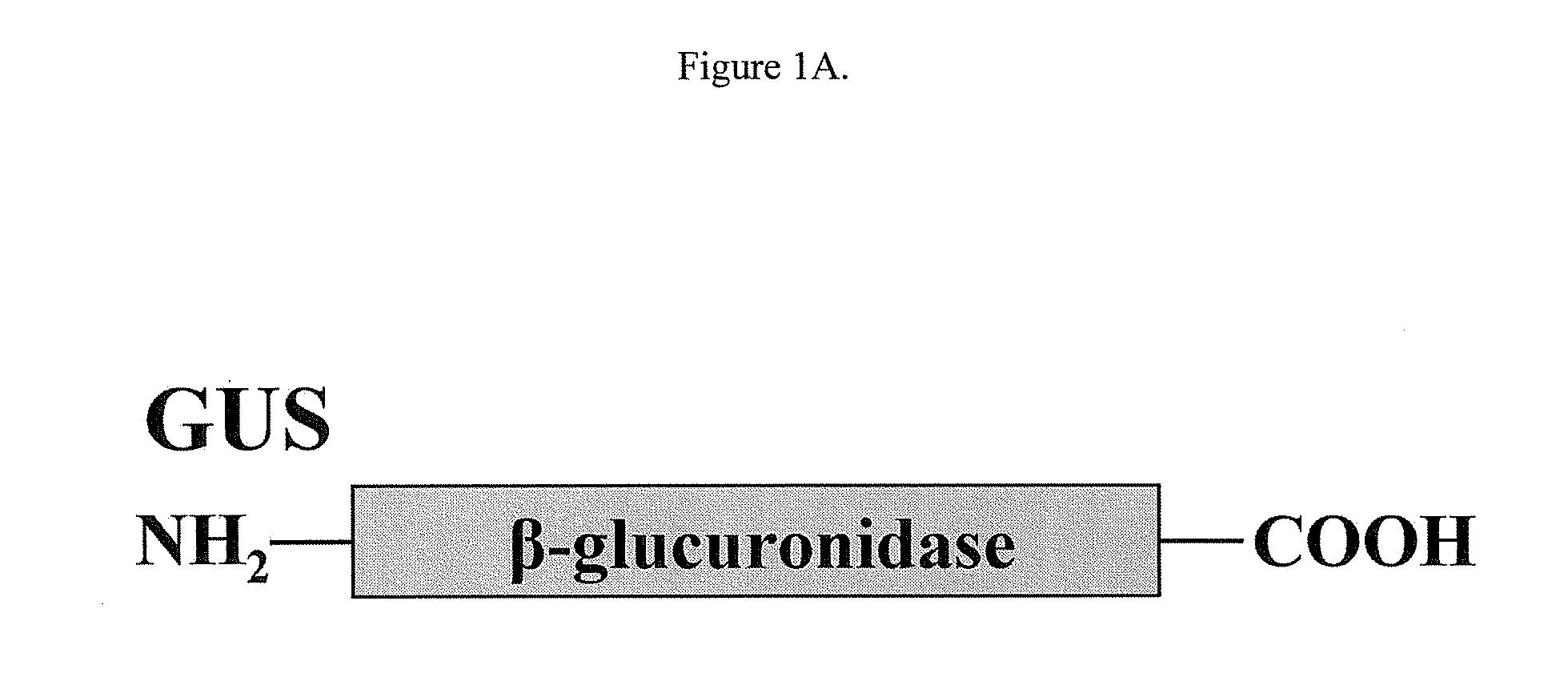Modified enzyme and treatment method
a technology of glucuronidase and modified enzymes, which is applied in the direction of transferases, peptide/protein ingredients, drug compositions, etc., can solve the problems of resistance to clearance of brain storage, little to no infused enzymes being able to cross the blood brain barrier, and little improvement, so as to improve the treatment of lsds and increase the half-life of the circulatory system
- Summary
- Abstract
- Description
- Claims
- Application Information
AI Technical Summary
Benefits of technology
Problems solved by technology
Method used
Image
Examples
example 1
Treatment of Purified GUS with Periodate and Borohydride
[0031]The mannose and manose 6-phosphate recognition sites on GUS are both located in the carbohydrate portion of GUS enzyme. In order to inactivate this carbohydrate moiety, the enzyme was treated by a well established procedure utilizing reaction with sodium meta-periodate followed by sodium borohydride (17, 18). Approximately 10 mg of purified GUS was treated with a final concentration of 20 mM sodium meta-periodate in 20 mM sodium phosphate, 100 mM NaCl pH 6.0 for 6.5 h on ice in the dark. The reaction was quenched by the addition of 200 mM final concentration ethylene glycol and incubated for an additional 15 min on ice in the dark. Afterwards, this mixture was dialyzed against 2 changes of 20 mM sodium phosphate, 100 mM NaCl pH 6.0 at 4° C. The periodate treated, dialyzed enzyme was then treated with the addition of 100 mM final concentration sodium borohydride overnight on ice in the dark to reduce reactive aldehyde grou...
example 2
Stability of Native GUS or PB-GUS
[0037]The carbohydrates on glycoproteins often confer enhanced thermal stability, and removal of oligosaccharide chains often destabilizes glycoproteins (21). Human GUS has been shown to be relatively stable to thermal inactivation at 65° C. (22-26). Purified GUS or PB-GUS was diluted in equal volumes of heat inactivation buffer [40 mM Tris-HCl (pH 7.5), 150 mM NaCl, 10 mg / ml BSA], and aliquots were incubated for 0, 0.5, 1, 2, or 3 h at 65° C. After treatment, aliquots were cooled on ice and then assayed for GUS activity. Results were expressed as the percentage of original units of GUS activity remaining at the indicated times. As shown in FIG. 2, recombinant GUS retained 90% of initial activity after 3 h at 65° C., whereas PB-GUS retained 40% of its activity under these conditions (FIG. 2).
[0038]To compare the stability of GUS and PB-GUS in lysosomes of living cells at 37° C., a study was conducted to determine their half-life after uptake by MPS V...
example 3
Clearance of the Periodate and Borohydride Treated GUS from the Circulation After IV Infusion
[0039]As stated previously, the purpose of treating GUS with periodate and borohydride, was to drastically slow its clearance time from the circulation after infusion. To test this, the tail veins of MPS VII mice were infused with GUS or PB-GUS at a dose of 4 mg / kg body weight in a total volume of 125 μl of PBS. After infusion, blood samples were taken by supraorbital puncture at 2, 5, 10, 20, 60, 90, and 120 min for GUS and 4, 240, 1,440, and 2,880 min for PB-GUS into heparinized capillary tubes. Plasma was collected after centrifugation and assayed for GUS activity. Values were expressed as a percentage of GUS activity remaining compared with the first time point. FIG. 4 and Table 3 below show the results of that clearance study. As can be seen, the clearance of untreated GUS is very rapid with a t1 / 2 of 11.7 min. In contrast, the clearance of PB-GUS in four separate mice was drastically s...
PUM
| Property | Measurement | Unit |
|---|---|---|
| pH | aaaaa | aaaaa |
| pH | aaaaa | aaaaa |
| contact time | aaaaa | aaaaa |
Abstract
Description
Claims
Application Information
 Login to View More
Login to View More - R&D
- Intellectual Property
- Life Sciences
- Materials
- Tech Scout
- Unparalleled Data Quality
- Higher Quality Content
- 60% Fewer Hallucinations
Browse by: Latest US Patents, China's latest patents, Technical Efficacy Thesaurus, Application Domain, Technology Topic, Popular Technical Reports.
© 2025 PatSnap. All rights reserved.Legal|Privacy policy|Modern Slavery Act Transparency Statement|Sitemap|About US| Contact US: help@patsnap.com



